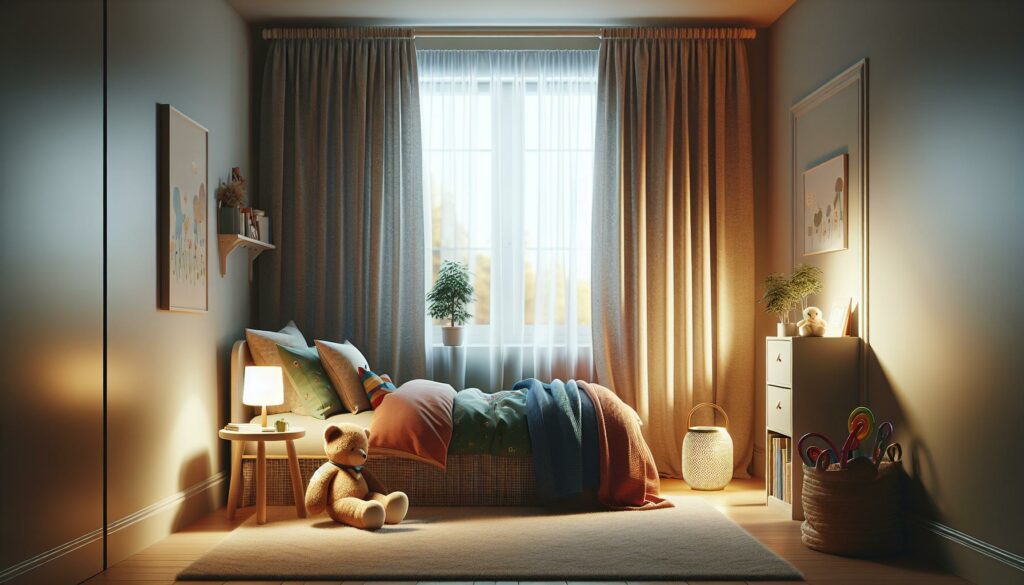As a parent I know how unsettling it can be to hear your toddler moaning in sleep. Those strange noises coming from their bedroom often leave us wondering if something’s wrong. After years of research and personal experience I’ve learned that sleep moaning in toddlers is actually quite common.
I’ve discovered that these nocturnal sounds typically aren’t cause for concern. Whether it’s gentle whimpers or loud groans most toddlers make various noises while sleeping as part of their natural sleep patterns and development. Understanding why these sounds occur and knowing when they might signal an underlying issue has helped me navigate this puzzling aspect of toddler sleep behavior.
Key Takeaways
- Sleep moaning in toddlers is generally normal and common, typically occurring during different sleep stages and transitions
- Most sleep sounds like humming, whimpering, and groaning are harmless unless accompanied by breathing difficulties, fever, or prolonged disruptions
- Medical attention is needed if moaning lasts over 10 minutes, comes with breathing problems, or causes daytime fatigue
- Environmental factors like room temperature (68-72°F), proper bedding, and consistent bedtime routines significantly impact sleep quality
- A structured sleep schedule with appropriate nap times and a 30-minute wind-down period helps reduce nighttime disturbances
Toddler Moaning in Sleep
Toddler sleep sounds encompass a variety of noises that range from soft murmurs to distinctive moans. Through my research and consultations with pediatric sleep specialists, I’ve identified specific patterns and meanings behind these nighttime vocalizations.
Common Sleep Noises and Their Meanings
Sleep-related sounds in toddlers follow distinct patterns that correspond to different sleep stages. Here are the most frequent types:
- Humming occurs during light sleep transitions
- Whimpering signals brief wake-ups between sleep cycles
- Groaning happens during deep sleep movements
- Talking reflects active dream states
- Grinding indicates tooth development or alignment
| Sleep Sound | Typical Duration | Sleep Stage |
|---|---|---|
| Humming | 2-3 seconds | Light sleep |
| Whimpering | 30-60 seconds | Transition |
| Groaning | 1-2 minutes | Deep sleep |
| Sleep talking | 5-30 seconds | REM sleep |
| Grinding | 2-5 minutes | Any stage |
When Moaning Is Normal vs Concerning
I’ve learned to differentiate between typical sleep sounds and potential warning signs:
Normal Sleep Sounds:
- Brief moans lasting 1-2 minutes
- Sounds that occur at consistent times
- Noises accompanied by normal breathing
- Vocalizations during sleep transitions
Concerning Signs:
- Persistent moaning lasting 10+ minutes
- Sounds paired with breathing difficulties
- Moaning with notable sleep disruptions
- Vocalizations accompanied by fever
- Nighttime sounds causing daytime fatigue
These distinctions help identify when toddler sleep sounds require medical attention versus normal developmental patterns.
Medical Conditions That Cause Sleep Moaning

Medical conditions affecting toddler sleep patterns often manifest through distinct moaning sounds during rest periods. These conditions range from respiratory issues to sleep disorders that require specific attention and treatment approaches.
Sleep-Related Breathing Issues
Sleep-related breathing problems in toddlers include obstructive sleep apnea mouth breathing. Here are key indicators:
- Snoring accompanied by pauses in breathing
- Gasping or choking sounds during sleep
- Mouth breathing with whistling or wheezing noises
- Heavy breathing patterns with chest retractions
- Restless sleep positions with head tilting backward
Common causes of breathing-related sleep moaning:
| Condition | Prevalence in Toddlers | Key Symptoms |
|---|---|---|
| Sleep Apnea | 1-4% | Loud snoring pauses mouth breathing |
| Enlarged Tonsils | 2-3% | Noisy breathing throat clearing |
| Seasonal Allergies | 8-10% | Congestion nasal sounds |
Night Terrors and Nightmares
Night terrors trigger intense moaning patterns distinct from typical nightmare responses. These episodes include:
Physical manifestations:
- Thrashing movements with loud moaning
- Sweating with rapid breathing
- Sitting upright while remaining asleep
- Eyes open but unresponsive
- Screaming or crying while moaning
- Occur within 2-3 hours after falling asleep
- Last 10-30 minutes per episode
- Happen during non-REM sleep stages
- Appear in clusters over several nights
- Peak between ages 2-4 years
Environmental Factors Affecting Toddler Sleep

Environmental factors create a direct impact on toddler sleep quality and sleep-related sounds. I’ve found through research that optimizing the sleep environment significantly reduces nighttime moaning and disruptions.
Room Temperature and Comfort
The ideal sleeping temperature for toddlers ranges between 68-72°F (20-22°C). Temperatures outside this range trigger restlessness sleep behaviors including moaning increased tossing turning. I recommend using:
- Breathable cotton bedding materials for temperature regulation
- Light pajamas in warm weather dark cotton in cold conditions
- A white noise machine set at 50-60 decibels to mask disruptive sounds
- Blackout curtains to block early morning light or street lamps
- A firm mattress with proper support for growing bodies
- Fixed bedtime between 7-8 PM for toddlers ages 1-3
- 30-minute wind-down period before sleep
- Calming activities: reading quiet play gentle music
- Dimmed lighting 1 hour before bedtime
- Regular nap schedule: 1-3 PM for optimal sleep pressure
- Morning wake time within 30 minutes of usual time
| Sleep Component | Recommended Duration |
|---|---|
| Nighttime Sleep | 11-14 hours |
| Daytime Nap | 1-3 hours |
| Wind-down Period | 30 minutes |
| Total Daily Sleep | 12-14 hours |
When to Consult Your Pediatrician
Immediate medical consultation is essential when a toddler’s sleep moaning accompanies specific symptoms or behavioral changes. Here are the key indicators that signal the need for professional evaluation:
Breathing-Related Signs:
- Loud snoring with 10-second or longer pauses in breathing
- Gasping or choking sounds during sleep
- Persistent mouth breathing throughout the night
- Excessive sweating during sleep
- Blue-tinted lips or fingernails
Sleep Pattern Changes:
- Frequent night wakings (4+ times per night)
- Extended periods of moaning lasting 30+ minutes
- Difficulty falling back asleep after waking
- Unusual daytime sleepiness
- Irritability or behavior changes due to poor sleep
Physical Symptoms:
- Morning headaches
- Unexplained weight changes
- Bedwetting after age 5
- Persistent sore throat
- Regular night terrors lasting beyond 30 minutes
- Frequent leg jerking or kicking
- Sleep walking episodes
- Unusual body positioning during sleep
- Rigid muscle tension while sleeping
- Head banging against the bed
I recommend documenting these symptoms in a sleep diary before the pediatrician visit:
- Time and duration of sleep episodes
- Types of sounds made
- Associated behaviors or movements
- Pre-bedtime activities
- Food intake 2-3 hours before sleep
This detailed record helps medical professionals determine if the sleep moaning indicates an underlying condition requiring treatment or represents normal toddler sleep patterns.
Tips for Better Toddler Sleep Quality
Create a Consistent Bedtime Routine
I recommend establishing a 30-minute routine that includes:
- Reading 2-3 short bedtime stories
- Playing soft lullaby music at 60-65 decibels
- Dimming lights to 50% brightness
- Giving a warm bath at 90-95°F
- Changing into comfortable pajamas made of breathable cotton
Optimize the Sleep Environment
The ideal sleep setting includes:
- Blackout curtains blocking 98% of external light
- White noise machine set at 65-70 decibels
- Room temperature maintained at 68-72°F
- Humidity levels between 30-50%
- Breathable cotton bedding with a thread count of 200-400
Time Naps Appropriately
Effective nap scheduling involves:
- Morning nap starting between 9-10 AM
- Afternoon nap beginning at 1-2 PM
- Limiting naps to 1-2 hours each
- Avoiding naps after 4 PM
- Maintaining 3-4 hours between last nap and bedtime
Monitor Physical Activity
Balance daily activities by:
- Scheduling 60-90 minutes of outdoor play
- Engaging in physical activities 3 hours before bedtime
- Including 15-20 minutes of gentle stretching
- Planning active games for morning hours
- Limiting screen time to 1 hour before bedtime
Manage Food and Drink Intake
Control evening consumption with:
- Last meal 2-3 hours before bedtime
- Small bedtime snack limited to 100-150 calories
- No caffeine-containing foods after 12 PM
- Water intake completed 60 minutes before bed
- Light protein snacks like 4 oz milk or 1 oz cheese
Address Sleep Interruptions
Handle nighttime wakings by:
- Waiting 3-5 minutes before responding
- Keeping interactions brief under 2 minutes
- Speaking in hushed tones below 30 decibels
- Using minimal lighting at 5-10% brightness
- Returning child to bed within 5-7 minutes
These practices align with creating optimal sleep conditions while addressing common factors that contribute to sleep moaning and disruptions in toddlers.
As a parent I know how concerning toddler moaning in sleep can be. Through my research and experience I’ve found that most sleep moaning in toddlers is completely normal and part of their development.
While occasional moaning rarely signals a problem it’s important to trust your parental instincts. I recommend monitoring your child’s sleep patterns and keeping track of any concerning symptoms. If you notice persistent issues or your toddler shows signs of distress during sleep don’t hesitate to consult your pediatrician.
Remember that creating an optimal sleep environment and maintaining consistent bedtime routines can significantly improve your toddler’s sleep quality. With the right approach and understanding you’ll feel more confident handling those nighttime noises.



